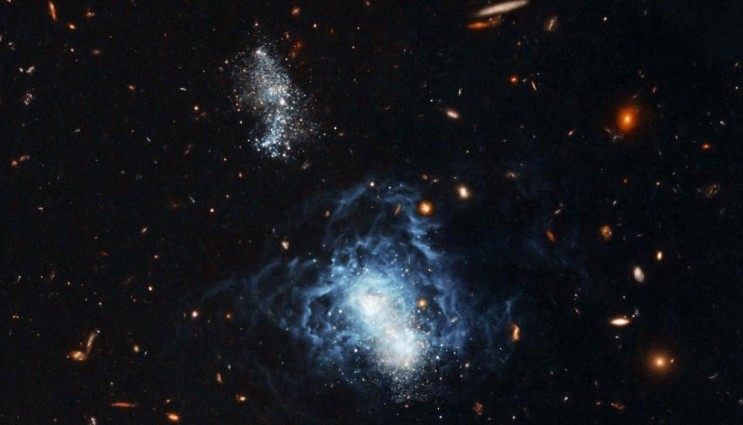New image tells story of distant galaxy
 (Download Image)
An image of the galaxy, dubbed NGC 4921, from 50 separate exposures through a yellow filter and another 30 exposures through a near-infrared filter using the Wide Field Channel of the Advanced Camera for Surveys on Hubble Space Telescope. The total exposure times were approximately 17 hours and 10 hours, respectively.
(Download Image)
An image of the galaxy, dubbed NGC 4921, from 50 separate exposures through a yellow filter and another 30 exposures through a near-infrared filter using the Wide Field Channel of the Advanced Camera for Surveys on Hubble Space Telescope. The total exposure times were approximately 17 hours and 10 hours, respectively.
In an effort to more accurately measure the expansion of the universe by looking at Cepheid variable stars in a distant galaxy, Kem Cook and colleagues are part of a collaboration that has created an exceptionally deep view of a strange galaxy.
Using images from NASA’s Hubble Space Telescope, a new image of the unusual spiral galaxy, dubbed NGC 4921, in the Coma Galaxy Cluster has been created.
Cook has been studying the variable stars in this galaxy since 2007 and used Hubble to obtain initial images. His team was using Hubble to search for Cepheid variable stars in NGC 4921 that could be used to measure the distance to the Coma Cluster and hence the expansion rate of the universe.
Stars are classified as variable if their apparent brightness as seen from Earth changes over time, whether the changes are due to variations in a star’s actual luminosity, or to variations in the amount of the star’s light that is blocked from reaching Earth.
The new image was created from 50 separate exposures through a yellow filter and another 30 exposures through a near-infrared filter using the Wide Field Channel of the Advanced Camera for Surveys on Hubble. The total exposure times were approximately 17 hours and 10 hours, respectively.
The Coma Galaxy Cluster, in the northern constellation of Coma Berenices (the hair of Queen Berenice) is one of the closest very rich collections of galaxies in the nearby universe. The cluster, also known as Abel 1656, is about 320 million light-years from Earth and contains more than 1,000 members. The brightest galaxies, including NGC 4921, were discovered back in the late 18th century by William Herschel.
The galaxies in rich clusters undergo many interactions and mergers that tend to gradually turn gas-rich spirals into elliptical systems without much active star formation. As a result, there are far more ellipticals and fewer spirals in the Coma Cluster than are found in quieter corners of the universe.
NGC 4921 is one of the rare spirals in Coma and is an example of an "anaemic spiral" where the normal vigorous star formation creating the familiar bright arms is much less intense. As a result there is just a delicate swirl of dust in a ring around the galaxy, accompanied by some bright young blue stars that are clearly separated out by Hubble’s sharp vision. In fact, the young stars are in regions much like the famous "Pillars of Creations," but the NGC 4921 pillars are hundreds of times larger. Much of the spiral structure in the outer parts of the galaxy is unusually smooth and gives the whole galaxy the look of a vast pale ghostly translucent jellyfish.
The long exposure times and sharp vision of Hubble also allowed it to not just image NGC 4921 in detail but also to see far beyond into the distant universe. All around, and even through the galaxy itself, thousands of much more remote galaxies of all shapes, sizes and colors are visible. Many have the spotty and ragged appearance of galaxies at a time before the familiar division into spirals and ellipticals had become established.
Cook’s team, which consisted of members from LLNL, the University of California, Davis, Texas A&M University, McMaster University and Herzberg Institute of Astrophysics, made initial images of the same galaxy during earlier studies.
The new image is a result of work by the Space Telescope Science Institute — the science operations center for the Hubble Space Telescope, the European Southern Observatory and European Space Agency.




